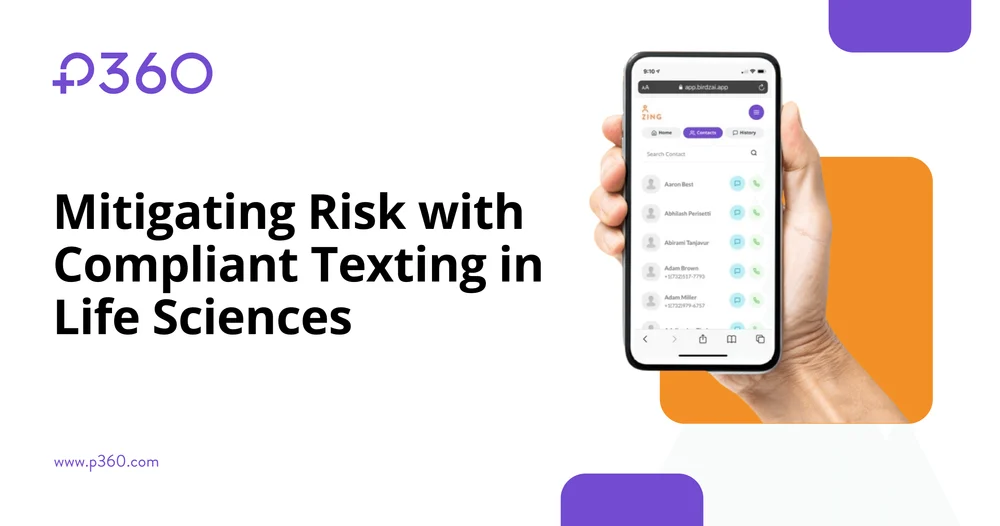Compliant Texting Solutions in Life Sciences: A Guide to Secure Messaging

by Kimberly Vaz | Last Updated: May 3, 2024 | 1 min read
Introduction to Compliant Texting in Life Sciences
In the life sciences industry, effective communication is crucial. It facilitates the seamless sharing of data between professionals and supports critical processes from research to patient care. However, as communication methods evolve with technology, the potential for non-compliant texting increases, posing significant risks to the integrity and privacy of sensitive information.
Non-compliant texting can lead to serious breaches in healthcare data privacy, exposing patient information and jeopardizing compliance with regulations like the Health Insurance Portability and Accountability Act (HIPAA). These breaches not only result in legal penalties but can also damage the trust that patients and partners place in healthcare providers.
Given these challenges, this article focuses on compliant texting strategies and best practices that harness AI solutions to enhance customer experience and ensure secure communication channels. By integrating HIPAA compliant messaging systems, life sciences organizations can protect sensitive data, streamline communications, and uphold the highest standards of privacy and data security. This approach not only mitigates risks but also boosts efficiency and trust, ultimately enhancing the overall customer experience in the healthcare sector.
Understanding the Regulatory Landscape in Life Sciences

In the life sciences industry, adhering to stringent regulatory standards is essential for safeguarding sensitive patient data and maintaining public trust. Regulations such as the Health Insurance Portability and Accountability Act (HIPAA) in the United States, various Food and Drug Administration (FDA) guidelines, and international frameworks like the General Data Protection Regulation (GDPR) in the European Union, define the boundaries of compliant communication practices, including compliant texting.
The Crucial Role of HIPAA in Healthcare Communication
HIPAA is designed to protect the privacy and security of patient information, a pivotal concern in the healthcare sector. It sets the standards for protecting sensitive patient data that healthcare providers, plans, and clearinghouses must follow. Under HIPAA, HIPAA Compliant Messaging must ensure that patient data is handled with utmost confidentiality and security during transmission and storage. This involves:
- Ensuring that all forms of communication, including texting, are conducted over secure platforms that encrypt data.
- Implementing safeguards that prevent unauthorized access to patient information.
The importance of HIPAA cannot be overstated, as non-compliance can result in significant penalties and damage to reputation, emphasizing the need for rigorous compliance measures in all patient-related communications.
FDA Regulations on Communication in the Life Sciences
The FDA regulates communication related to pharmaceuticals and medical devices to ensure that all information disseminated is accurate, scientifically valid, and not misleading. This includes communications about drug approvals, clinical trials, and marketing practices. For life sciences companies, compliance with FDA regulations means:
- Ensuring that all promotional texts and messages are backed by scientific evidence and do not exaggerate benefits or downplay risks.
- Maintaining transparency in communications about drug effectiveness and side effects to avoid misleading healthcare providers and patients.
Adhering to these regulations is critical not only for compliance but also for maintaining the integrity and credibility of communications within the pharmaceutical industry.
Navigating International Regulations Like GDPR
For organizations operating in or dealing with the European market, understanding and complying with GDPR is crucial. GDPR imposes strict rules on data privacy and gives individuals significant control over their personal data, impacting how organizations handle information transfer, including texting. Compliance with GDPR involves:
- Ensuring that personal data is processed transparently and kept secure from unauthorized access.
- Obtaining clear consent from individuals before collecting or processing their data, with particular attention to sensitive health information.
Organizations must be vigilant in aligning their compliant texting practices with GDPR to avoid substantial fines and uphold commitments to Healthcare Data Privacy across borders.
Explore More Relevant Articles on P360
- ZING Features Two-Way Voice Calling and Instant Video Calling
- The ZING Engagement Suite Makes Scheduling with HCPs a Breeze
- ZING Enables Compliant Messaging With HCPs for better HCP Engagement
- P360 Launches ZING to Help Pharma Sales Team to Improve HCP Engagement
- How COVID-19 Changed HCP Practices and How Pharma Needs to Adapt
- Compliant Texting Solutions in Life Sciences: A Guide to Secure Messaging
Challenges of Compliant Texting in Life Sciences

Texting has become a ubiquitous communication tool due to its convenience and immediacy, making it highly popular in the life sciences sector for quick consultations and updates. However, this popularity comes with inherent risks that can compromise patient data security and regulatory compliance.
Risks of Unencrypted Messaging
One of the primary challenges in using texting for communication within life sciences is the issue of unencrypted messages. When messages are sent without encryption, they are susceptible to being intercepted by unauthorized parties. This poses a significant risk, especially when sensitive health information is shared. Without the protection of encryption, patient data security can be easily compromised, leading to potential breaches of healthcare data privacy.
- Texts that contain protected health information (PHI) must be encrypted to comply with HIPAA compliant messaging standards.
- The lack of encryption makes it easier for cyber attackers to access sensitive data.
Lack of Proper Documentation
Another significant challenge is the lack of proper documentation that often accompanies texting. In many instances, text messages are not automatically integrated into the patient’s health records, leading to gaps in medical documentation and continuity of care. This absence of integration can hinder the ability of healthcare providers to track the full context of patient interactions and treatment history.
- Messages must be archived and easily retrievable to meet texting regulatory compliance requirements.
- Proper documentation ensures that all communications are recorded and can be reviewed during audits or legal inquiries.
Mobile Device Vulnerabilities
The widespread use of mobile devices for texting introduces another layer of risk. Mobile devices can be lost, stolen, or accessed by unauthorized users, all of which threaten the security of sensitive information stored or accessed on these devices.
- Mobile security policies are crucial to ensure that devices are protected with strong authentication measures and that they can be remotely wiped if lost or stolen.
- Regular security updates and training on mobile device management for staff are essential to protect against vulnerabilities.
Best Practices for Compliant Texting in Life Sciences
In the life sciences industry, the importance of maintaining communication integrity cannot be understated. Compliant texting is pivotal, ensuring that sensitive information is protected while adhering to stringent regulatory requirements. Here, we explore the best practices that can help organizations enhance customer experience through secure and efficient communication strategies.
Secure Messaging Platforms: Safeguarding Communication
Introduction to Technologies Like the ZING Engagement Suite:
Secure messaging platforms are indispensable in the life sciences sector. Technologies like the ZING Engagement Suite are at the forefront of these solutions, offering robust features tailored to meet the industry’s unique needs.
Benefits of Using End-to-End Encryption and Audit Trails:
End-to-end encryption ensures that messages remain confidential, only accessible to the sender and the intended recipient. Audit trails, meanwhile, provide a chronological record of all communications, which is crucial for compliance with regulations like HIPAA Compliant Messaging. This feature not only enhances Healthcare Data Privacy but also aids in the seamless tracking of data for auditing purposes.
Training and Policies: Cultivating a Culture of Compliance
Importance of Training Staff on Compliance Protocols:
Training is a cornerstone of any compliance strategy. Employees must be educated on the nuances of HIPAA Compliant Messaging and other relevant regulations to prevent inadvertent breaches that could compromise patient data security.
Developing Clear Texting Policies and Procedures:
Clear, concise policies and procedures must be developed and communicated throughout the organization. These guidelines should define permissible texting practices and outline the measures to be taken in the event of a security breach, ensuring all team members are informed and accountable.
Technical Safeguards: Implementing Robust Security Measures
Encryption of Sensitive Information:
Encrypting sensitive information is fundamental to secure messaging. This technical safeguard prevents unauthorized access to patient data, thus maintaining the confidentiality and integrity of sensitive communications.
Implementation of Access Controls and Device Management:
Access controls are critical in regulating who can view sensitive information. Effective device management ensures that lost or stolen devices do not become a source of data leakage, thereby maintaining strict Healthcare Data Privacy.
Monitoring and Integration: Ensuring Continuous Compliance
Regular Monitoring and Auditing of Texting Activities:
Ongoing monitoring and regular auditing of texting activities are essential to ensure continuous adherence to compliance protocols. These practices help identify and rectify potential vulnerabilities, thereby reducing the risk of non-compliance.
Integration of Texting with Electronic Health Records (EHR):
Integrating texting solutions with EHR systems can significantly enhance the flow of information. This integration ensures that all communications are logged and accessible within the patient’s health record, providing a comprehensive view of the patient’s interactions and improving the continuity of care.
Data Management: Preserving the Integrity of Communications
Strategies for Message Retention and Archiving:
Message retention and archiving are critical components of compliant texting. Organizations must implement strategies that not only meet regulatory requirements but also provide easy access to historical communications for legal and auditing purposes.
Updating Security Measures Regularly:
As technology and threats evolve, so must security measures. Regular updates to security protocols ensure that the organization stays ahead of potential threats and continues to protect sensitive information effectively.
Conclusion: Embracing Compliant Texting in Life Sciences
In conclusion, the significance of compliant texting in the life sciences industry cannot be overstated. It serves as a critical tool for mitigating risks associated with the handling of sensitive information and maintaining stringent compliance with regulations such as HIPAA.
Recap of the Significance of Compliant Texting
Compliant texting has been shown to be instrumental in enhancing the security and efficiency of communications within life sciences. By integrating technologies like secure messaging platforms, organizations can ensure that every message sent and received adheres to the highest standards of Healthcare Data Privacy and compliance. This adherence not only protects patient information but also safeguards organizations against potential legal and financial penalties.
It is imperative for life sciences organizations to adopt the best practices outlined throughout this discussion. Investing in Secure Messaging Platforms and training staff in HIPAA Compliant Messaging protocols are essential steps toward achieving a robust compliant texting framework. These actions are crucial not only for compliance but also for enhancing the overall customer experience through reliable and secure communication channels.
Final Thoughts on the Balance Between Efficient Communication and Compliance
Maintaining a balance between efficient communication and rigorous compliance presents a significant challenge for life sciences organizations. However, with the right tools and strategies in place, it is possible to achieve this balance. Compliant texting not only facilitates seamless and efficient communication but also ensures that every interaction is conducted within the legal boundaries set by regulatory bodies.
By prioritizing Compliant Texting and the implementation of comprehensive security measures, life sciences organizations can foster an environment of trust and safety that benefits both providers and patients alike. This commitment to compliance and effective communication is essential for the continued success and integrity of the life sciences industry.
Take the Next Step in Enhancing Your Compliant Texting Practices
With constantly evolving life science industry, maintaining robust communication practices is crucial. To ensure your organization adheres to the highest standards of HIPAA Compliant Messaging and Healthcare Data Privacy, a proactive approach to evaluating and improving your texting practices is essential.
- It is strongly recommended that your organization conducts regular reviews of your current messaging systems and policies. This will help identify any gaps in compliance and areas for enhancement.
- For expert guidance and more detailed insights, reach out to our compliance expert. At P360 we can provide tailored advice and help streamline your communication strategies to ensure they meet all regulatory requirements.
Moreover, consider adopting the ZING Engagement Suite, a Secure Messaging Platform that offers comprehensive solutions for all your compliant texting needs. This platform not only secures sensitive information but also integrates seamlessly with existing systems to enhance operational efficiency and compliance.
By taking these steps, your organization can significantly enhance its communication protocols, ensuring they are secure, efficient, and compliant.
